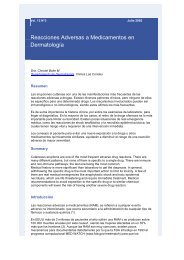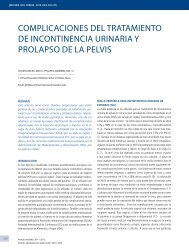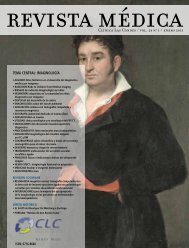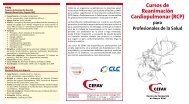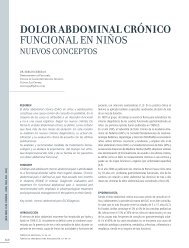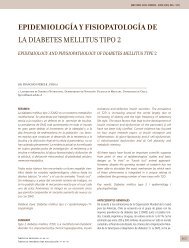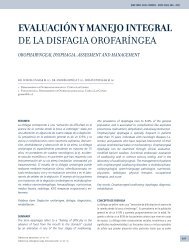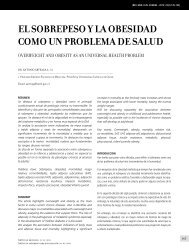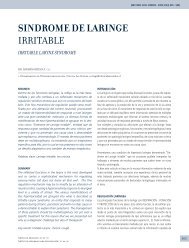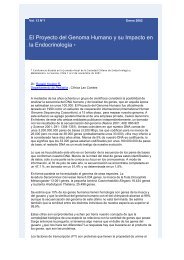11 - ClÃnica Las Condes
11 - ClÃnica Las Condes
11 - ClÃnica Las Condes
You also want an ePaper? Increase the reach of your titles
YUMPU automatically turns print PDFs into web optimized ePapers that Google loves.
FIGURA 2. MECANISMOS FISIOPATÓLÓGICOS DEL SAOS Y ENFERMEDAD VASCULARSAOS• Hipoxemia• Reoxigenación• Hipercapnia• Pº esofágica (-)• MicrodespertaresMediadores -Mecanismos• Activación simpática-Vasoconstricción-Catecolaminas(+)-Taquicardia-Alt. variabilidad CV• Disfunción endotelial• Estrés oxidativo• Inflamación• Alteraciones metabólicas-Resistencia leptina-Obesidad-Resistencia insulinaEnfermedades vasculares• Hipertensión arterial• Insuficiencia cardiaca congestiva-Disfunción sistólica-Disfunción diastólica• Arritmias cardíacas-Bradicardias-Bloqueo AV-Fibrilación auricular• Isquemia miocárdica-Cardiopatía coronaria-Angor nocturno-Depresión ST noche• Enfermedad cerebrovascularSAOS: Síndrome de Apnea-Hipopnea Obstructiva del Sueño; Pº: presión; CV:cardiovascular;.Modifi cado de Shamsuzzaman AS, Gersh BJ, Sommers VV. Obstructive sleep apnea complications and cardiovascular disease. JAMA. 290:1906-14, 2003.como lo demuestran varios artículos del Wisconsin Sleep Cohort Study.Young y colaboradores (38) encontraron una mayor prevalencia de hipertensióncon el aumento de gravedad del SAOS, medido por el índicede apnea-hipopnea (IAH, el número de eventos por hora de sueño).Otros estudios también demostraron un mayor riesgo de hipertensiónen pacientes con SAOS independiente de otros factores (39, 40, 41).aterosclerosis incluyen un aumento de la actividad simpática duranteel sueño, el desarrollo de resistencia a la insulina, disfunción endotelial,y el aumento de la hipercoagulabilidad, el estrés oxidativo y la infl a-mación. SAOS está asociado con niveles elevados de citoquinas proinflamatorias, moléculas de adhesión, fi brinógeno en plasma, actividadplaquetaria y reducción de la capacidad fi brinolítica.[REV. MED. CLIN. CONDES - 2008; 19(5) 477- 489]Desde un punto de vista clínico, es importante señalar que, incluso unSAOS leve, incrementará el riesgo para hipertensión. Se demostró unpequeño aumento adicional de la presión arterial acorde a la gravedaddel SAOS en un estudio prospectivo de más de 2600 sujetos (42) conun aumento de la presión arterial sistólica y diastólica de 1 mm Hg y0,7 mm Hg, respectivamente, con cada aumento de 10 puntos del IAH.En otro gran estudio de 1087 individuos, hubo una incidencia similarde hipertensión arterial para los grupos con IAH de 5 a 20, 20 a 40, ymás de 40. Sin embargo, el odds-ratio de hipertensión mal controlada(mayor o igual a 160/95 mm Hg) fue 4,15 en los sujetos con un IAH demás de 40 años, y sólo 1,5 a 2,15 en sujetos con enfermedad leve omoderada, en comparación con los sujetos sin apnea del sueño (43).Esta relación entre la hipertensión y el SAOS puede ser particularmenteimportante, en los casos de hipertensión resistente a tratamiento.Otras enfermedades cardiovasculares y SAOS: En la edad media de lavida, los pacientes con SAOS tienen un mayor riesgo de cardiopatíaisquémica independiente de la edad, IMC, presión arterial y tabaquismo.Este riesgo se reduce al revertir las apneas obstructivas del sueño.Los posibles mecanismos responsables del SAOS relacionados con la4.2. SAOS y accidente vascular cerebralEstudios recientes indican que el SAOS puede ser un factor de riesgoindependiente para el desarrollo de accidentes cerebrovasculares (44,45) y la terapia de SAOS pueden ayudar a reducir riesgo cardiovasculary cerebrovascular (46).Un gran estudio prospectivo en varones fi nlandeses mostró un aumentoen el riesgo relativo de 2 veces para el resultado combinado de accidentecerebrovascular y cardiopatía coronaria en roncadores habitualescomparados con no roncadores (47). Una pequeña, pero signifi cativaasociación positiva (riesgo relativo 1,33) se observó en las mujeres delNurses Health Study (48) entre ronquido regular y el resultado combinadode accidente cerebrovascular y cardiopatía isquémica.En cuanto a la prevalencia de SAOS en enfermedad cerebrovascular,los estudios están sesgados, pues estudian sólo los sobrevivientes. Porotra parte, la lesión de centros respiratorios, pueden provocar apneascentrales y obstructivas post-accidente vascular, por lo cual no sabemoscuál era la condición previa.<strong>Las</strong> características de la respiración también pueden cambiar signifi -cativamente en el período post-accidente vascular. Varios estudios han482REV.MEDICA VOL.19 NOV.indd 482 3/<strong>11</strong>/08 12:24:38
demostrado una tendencia signifi cativa tanto de la intolerancia a laglucosa como de resistencia a la insulina entre los distintos grados deseveridad del SAOS.Tamura (70) estudió a 129 japoneses con índice de apnea-hipopnea mayora 5, observando un compromiso en el metabolismo de la glucosa en un60.5% con un aumento de la prevalencia según la severidad del SAOS.Algunos autores (71, 72) señalan que el tratamiento del SAOS conllevauna mejoría en el metabolismo de la glucosa, sugiriendo que SAOSpuede ser un factor independiente para intolerancia a la glucosa, y eventualmentepara diabetes mellitus. Sin embargo, otros datos no muestranesa mejora (73). Los modelos animales muestran que la apnea obstructivainduce una disfunción metabólica a través de ciclos de hipoxia intermitente;se han propuesto mecanismos fi siopatológicos subyacentesincluyendo estrés oxidativo, activación simpática e infl amación.Figura 3: CPAP nasal.[REV. MED. CLIN. CONDES - 2008; 19(5) 477- 489]Ya sea que el SAOS se produce como parte fundamental de la fi siopatologíadel síndrome metabólico o si el SAOS promueve el desarrollo delsíndrome metabólico, es algo que todavía debe ser más estudiado.5. Tratamiento del SAOS y sus efectosa. Manejo del sobrepeso u obesidad.b. Terapia posicional.c. Evitar sedantes y alcohol.d. Presión positiva a la vía aérea superior (CPAP, BiPAP, AutoCPAP).e. Aparatos de avance mandibular.f. Cirugía: Uvulopalatofaringoplastía, Tonsilectomía y otras.La obesidad es la causa aislada más importante de SAOS, por lo tantoun punto cardinal de la terapia es la reducción de peso para mejorarla efi ciencia del sueño, disminuir el ronquido y mejorar de la oxigenación.Los resultados más dramáticos se han comunicado con la cirugíabariátrica (75, 76, 77).Dado que las apneas son, a menudo, peores o se presentan exclusivamenteen la posición supina, se pueden implementar técnicas paramantener el decúbito lateral durante el sueño, ej: un objeto incómodocosido en la parte posterior del pijama.El CPAP (Continuous Positive Airway Pressure) nasal sigue siendo eltratamiento primario para pacientes con SAOS particularmente moderadoa severo (78, 79), consta de una mascarilla conectada a un ventiladorque mantiene una presión positiva en la vía aérea superior a undeterminado nivel (Fig. N° 3), actuando como una manga neumáticaque mantiene la vía aérea permeable (80, 81) tal como se ilustra en laFig. 1.B. La presión ideal se determina generalmente en el Laboratoriode Sueño, defi niendo la presión capaz de eliminar ronquido, apneas,hipopneas durante todas las fases del sueño y posiciones, y que permitela aparición de sueño lento y sueño REM. Hoy en día, gracias a laexistencia de equipos más modernos, ha mejorado signifi cativamentela adherencia y tolerancia a largo plazo al uso de CPAP.Efectos del tratamiento sobre la hipertensión arterialCon la fuerte asociación demostrada entre hipertensión arterial y SAOS,cabría esperar una sustancial reducción de la presión con tratamientoefi caz de las apneas de sueño. De hecho, estudios no controlados en lafase previa a la medicina basada en la evidencia mostraron una marcadareducción de la presión arterial, tanto durante la noche como dedía, en SAOS tratados con CPAP. Sin embargo, estudios controladoshan demostrado resultados contradictorios. No hubo disminución significativa en presión arterial media de tratamiento con CPAP en cincoestudios (82, 83, 84, 85, 86) y una pequeña disminución de la diastólica(-1,4 mmHg) (87) o diastólica y presión arterial media durante eldía, de aproximadamente 2 mmHg (88). Sólo tres estudios demostraronuna importante reducción de la presión arterial media entre 2,5 y 9,9mmHg (89). La caída en la presión promedio de 24 horas del día, no essólo por reducción de la presión arterial durante la noche, sino tambiéna causa de una disminución de la presión arterial diurna.Se han publicado 3 meta-análisis del efecto del tratamiento de SAOScon CPAP, en la presión arterial. Uno de ellos fue restringido a estudiosque incluían registros ambulatorios de presión arterial (90), el otro paralos ensayos con duración del tratamiento de 2 semanas. Este últimoincluyó pacientes con SAOS e insufi ciencia cardiaca y pacientes conSAOS y función sistólica normal (91). En general, la reducción neta dela presión arterial fue de 2 mmHg, importante pero modesto.Un tercer meta-análisis (92) incluyó ensayos controlados randomizadosque informaron las presiones sistólica y diastólica antes y después delCPAP, mostrando una reducción modesta (1,5 mmHg) en ambas presiones.En 6 estudios que evaluaron SAOS más graves (IAH 30), el CPAPredujo en 3 mmHg la sistólica y 2 mmHg la diastólica.Considerados en conjunto, estos estudios sugieren que hay un efectomoderado y variable del CPAP en el tratamiento del SAOS, sobre lapresión arterial. Los pacientes con SAOS más grave, con hipertensiónarterial de difícil manejo y con mejor adherencia al uso de CPAP puedenmostrar reducciones más signifi cativas.484REV.MEDICA VOL.19 NOV.indd 484 3/<strong>11</strong>/08 12:25:02
Efectos del tratamiento sobre los accidentes vasculares cerebralesEl uso de CPAP aumenta el potencial de rehabilitación después de unaccidente cerebrovascular. Desgraciadamente, la adherencia al uso delCPAP no ha sido buena en los pacientes que se recuperaban de un accidentecerebrovascular, y los efectos benefi ciosos no se han confi rmado(96, 97). En un estudio prospectivo después de un accidente cerebrovascularisquémico agudo, Bassetti et al (98) encontraron que sólo el15% de las personas con apnea del sueño seguían usando el CPAP. Sinembargo, Wessendorf et al (99) estudiando en forma prospectiva 105pacientes con accidente cerebrovascular y SAOS encontraron que el70% continuaba su tratamiento en casa.Varios estudios sugieren que el SAOS en el paciente post-accidentevascular cerebral reduce la motivación, disminuye la capacidad cognitiva,y puede aumentar el riesgo de accidente cerebrovascular recurrentey muerte. Dyken et al observaron que los pacientes después de un accidentecerebrovascular tienen una alta prevalencia de SAOS, mostrandoeste grupo: supervivencia marcadamente disminuida (100), deteriorofuncional, mayores tiempos de hospitalización y rehabilitación (101).Se cree que el efecto benefi cioso del CPAP en el riesgo de accidentecerebrovascular no es sólo por la reducción de la presión arterial, dadoque además el CPAP estabiliza la oxigenación; reduce la actividad simpáticay los niveles de catecolamina (102); mejora la función ventricularizquierda (103); disminuye la agregación plaquetaria, los niveles plasmáticosde fi brinógeno y marcadores infl amatorios de la ateroesclerosis(104), y reduce el riesgo de fi brilación auricular (105).8. Conclusiones de SAOSEl SAOS es un problema de salud pública tanto en países desarrolladoscomo en vías de desarrollo, adoleciendo estos últimos de recursos necesariospara su diagnóstico y tratamiento. La creciente investigación,particularmente relacionado con la magnitud del problema y las consecuenciaspara la sociedad han permitido dar a los trastornos respiratoriosdurante el sueño la importancia que tienen.Sabemos que un SAOS no tratado llevará a una somnolencia excesiva,disminución del rendimiento laboral y una reducción en la calidad devida (106), así como una mayor mortalidad por todas las causas, particularmentecardiovasculares.La clave que asocia SAOS con enfermedad cardiovascular parece radicaren la activación simpática crónica. Otros mecanismos son: inflamación, disfunción endotelial, niveles aumentados de endotelina,hipercoagulabilidad y estimulación del eje renina-angiotensina. SAOS,hipertensión y obesidad a menudo coexisten e interactúan a través devarios mecanismos fi siopatológicos provocando consecuencias cardioy cerebrovasculares.Es un hecho que futuras investigaciones, nos permitirán comprendermejor la relación bi-direccional que existe entre el sueño, trastornoscardiovasculares y disfunción metabólica. Particularmente relevante esel impacto potencial del tratamiento del SAOS en la prevención y manejode la hipertensión, cardiopatía isquémica, insufi ciencia cardiacacongestiva, accidentes cerebrovasculares y síndrome metabólico.BIBLIOGRAFÍA1. MacNisch R. The Philosophy of Sleep. New York, NY:D Appleton &Co; 1834.2. Hobson J. Sleep. New York, NY: Scientifi c American Library; 1989.3. American Academy of Sleep Medicine. Internacional classsifi cation ofsleep disoders. 2nd edition: Diagnostic and coding manual. Westchester(IL): American Academy of Sleep Medicine; 2005.4. Roth T. Insomnia: defi nition, prevalence, etiology and consequences.J Clin Sleep Med 2007;3:S7-S10.5. Reiman D, et al. J Affect Disord 2003;76:255-259.6. Cole MG, et al. Am J Psychiatry 2003, 160:<strong>11</strong>47-<strong>11</strong>56.7. Espie CA et al Sleep 2007;30(5):574-584.8. Ford DE, Kamerow DB. Epidemiologic study of sleep disturbancesand psychiatrics disorders: an opportunity for prevention?JAMA1989;262:1479-1484.9. Bastien CH, Vallieres A, Morin CM. Precipitatng factors of insomnia.Beba Sleep Med 2004;2:50-62.10. Mai E, Daniel MD, Buysse J. Insomnia: Prevalence, impact,pathogenesis, differential diagnosis and evaluation. Sleep Med Clin2008;3(2):167-174.<strong>11</strong>. National Institutes of Health. National Institutes of Health State ofthe Science conference statement on manifestations and managementof chronic insomnia in adults. Sleep 2005;28(9):1049-1057.12. Edinger JD, Means MK. Overview of insomnia: defi nitions,epidemiology, differential diagnosis, and assessment. In: Kryger MH,Roth T, Dement WC, editors. Principles and practice of sleep medicine.4th edition. Philadelphia: Elsevier Saunders; 2005:702-713.13. Hajak G, SINE Study Group, Study of Insomia in Europe:Epidemiology of severe insomnia and its consequences in Germany. EurArch Psychiatry Clin Neurosci 2001;251:49-56.14. Morgenthaler T, Kramer M, Alessi C, Friedman L, et al. Practiceparameters for the psychological and behavioral treatment of insomnia:an update. An American Academy of Sleep Medicine Report. Sleep2006;29(<strong>11</strong>):1415-1419.15. McCall WV. A psychiatric perspective of insomia. J Clin Psychiatry2001;62 (Suppl 10): 27-32.16. Ford DE, Kamerow DB. Epidemiologic study of sleep disturbances[IMPACTO DE LOS TRASTORNOS DEL SUEÑO EN LA SALUD DE LAS PERSONAS: INSOMNIO Y SÍNDROME DE APNEA DEL SUEÑO - DRA. LARISA FABRES O.]485REV.MEDICA VOL.19 NOV.indd 485 3/<strong>11</strong>/08 12:25:12
and psychiatrics disorders: an opportunity for prevention? JAMA1989;262:1479-1484.17. Katz DA, McHorney CA. The relationship between insomnia andhealth-related quality of life in patients with chronic illness. J Fam Pract2002;51(3):229-235.18. Taylor DJ, Lichstein KL, Durrence HH et al. Epidemiology of insomnia,depression, and anxiety. Sleep 2005; 28(<strong>11</strong>):1457-1464.Proc; 74:955–958, 1999.32. Somers V,White D, Amin R et al AHA/ACCF Sleep Apnea andCardiovascular Disease. Circulation; <strong>11</strong>8: published online Jul 28,2008.33. McNicholas WT, Bonsignore MR. Sleep apnoea as an independentrisk factor for cardiovascular disease: current evidence, basic mechanismand research priorities. Eur Respir J;29: 156–78, 2007.[REV. MED. CLIN. CONDES - 2008; 19(5) 477- 489]19. Chilcota LA, Shapiro CM. The socioeconomic impact of insomnia.Pharmacoeconomics 1996;10:1-14.20. Stoller MK. Economic effects of insomnia (review) Clin Ther1994;16:873-897.21. Zorick F, Walsch J. Insomnia. In: Principles and practice of SleepMedicine, 3rd edition. Kryger M, Dement W, Roth T. WD SaundersCompany, Philadelphia, 2000:620-622.22. Lundahl, et al. Psychopharmacology 2007; 195(1): 139-146.23. Roth T, et al. Sleep Med; 2006:312-31.24. Neubauer DN.Opin Investig Drugs 2005:1269-1276.25. Somers V.K, Phil D, Dyken M.E, et al. Sympathetic-nerve activityduring sleep in normal subjects. N Engl J Med;328(5): 303-307,1993.26. Hedner J, Ejnell H, Sellgren J, et al. Is high and fl uctuating musclenerve sympathetic activity in the sleep apnoea syndrome of pathogeneticimportance for the development of hypertension?. Hypertens Suppl 6;S529-S531,1988.27. American Academy of Sleep Medicine. Internacional Classifi cationof sleep disorders. Wetchester (IL): AASM; 2005.28. Young T, Palta M, Dempsey J et al. The occurrence of sleep-disorderedbreathing among middle-age adults. N Engl J Med; 328:1230-1235,1993.29. Dran J, Esnaola S, Rubio R, et al. Obstructive sleep apnoea-hypopneaand related clinical features in a population-based simple of subjectsaged 30 to 70 yr. Am J Resp Crit Care Med; 163:685-689, 2001.30. Tishler PV, Larkin EK, Schluchter MD, et al. Incidence of sleepdisorderedbreathing in an urban adult population: the relativeimportance of risk factors in the development of sleep-disorderedbreathing. JAMA; 289:2230–2237, 2003.31. Beninati W, Harris CD, Herold DL, et al. The effect of snoring andobstructive sleep apnea on the sleep quality of bed partners. Mayo Clin34. Coccagna G, Mantovani M, Brignani F, et al. Continuous recordingof the pulmonary arterial pressure during sleep in syndromes ofhypersomnia with periodic breathing. Bull Physiopathol Respir(Nancy);8(5): <strong>11</strong>59-<strong>11</strong>72, 1972.35. Silverberg DS, Oksenberg A, Iaina A. Sleep-related breathingdisorders as a major cause of essential hypertension: fact or fi ction?Curr Opin Nephrol Hypertens;7:353–35, 1998.36. Williams AJ, Houston D, Finberg S, Lam C, Kinney JL, SantiagoS. Sleep apnea syndrome and essential hypertension. Am J Cardiol;55:1019 –1022, 1985.37. Young T, Javaheri S. Systemic and pulmonary hypertension in obstructivesleep apnea. In: Kryger MH, Roth T, Dement WC, ed. Principles andpractices of sleep medicine, 4th edition WB SaundersPhiladelphia;<strong>11</strong>92-1202, 2005.38. Young T., Peppard P., Palta M., et al: Population-based study ofsleep-disordered breathing as a risk factor for hypertension. ArchIntern Med;157:1746-1752,1997.39. Bixler E.O., Vgontzas A.N., Lin H.M., et al. Association of hypertensionand sleep-disordered breathing. Arch Intern Med;160(15): 2289-2295,2000.40. Duran J., Esnaola S., Rubio R., et al. Obstructive sleep apneahypopneaand related clinical features in a population-based sampleof subjects aged 30 to 70 yr. Am J Respir Crit Care Med;163(3 Pt 1):685-689, 2000.41. Nieto F.J., Young T.B., Lind B.K., et al. Association of sleep-disorderedbreathing, sleep apnea, and hypertension in a large community-basedstudy. Sleep Heart Health Study. JAMA; 283(14): 1829-1836,2000.42. Lavie P., Herer P., Hoffstein V. Obstructive sleep apnoea syndromeas a risk factor for hypertension: population study. BMJ;320(7233):479-482, 2000.43. Grote L., Ploch T., Heitmann J., et al. Sleep-related breathingdisorder is an independent risk factor for systemic hypertension. Am JRespir Crit Care Med;160(6): 1875-1882, 1999.486REV.MEDICA VOL.19 NOV 486 26/10/08 17:51:04
44. Arzt M, Young T, Finn L, et al. Association of sleep-disorderedbreathing and the occurrence of stroke. Am J Respir Crit Care Med;172:1447–1451, 2005.45. Yaggi HK, Concato J, Kernan WN, Lichtman JH, Brass LM, MohseninV. Obstructive sleep apnea as a risk factor for stroke and death. N EnglJ Med;353:2034 –2041, 2005.57. Chin K, Shimizu K, Nakamura T, et al. Changes in intra-abdominalvisceral fat and serum leptin levels in pateints with obstructive sleepapnea syndrome following nasal continuous positive airway pressuretherapy. Circulation; 100:706–712, 1999.58. Flier JS, Elmquist JK. A good night’s sleep: future antidote to theobesity epidemic? Ann Intern Med;141:885–886, 2004.46. Marin JM, Carrizo SJ, Vicente E, et al. Long-term cardiovascularoutcomes in men with obstructive sleep apnoea-hypopnoea withor without treatment with continuous positive airway pressure: anobservational study. Lancet;365(9464): 1046–1053, 2005.47. Koskenvuo M, Kaprio J, Telakivi T, et al. Snoring as a risk factorfor ischaemic heart disease and stroke in men. Br Med J (Clin ResEd);294:16–19, 1987.48. Hu F, Willet W, Manson J, et al. Snoring and the risk of cardiovasculardisease in women. J Am Coll Cardiol;35:308–313, 2000.49. Bassetti C, Aldrich MS, Chervin RD, Quint D. Sleep apnea in patientswith transient ischemic attack and stroke: a prospective study of 59patients. Neurology;47:<strong>11</strong>67–<strong>11</strong>73, 1996.50. Bassetti CL, Milanova M, Gugger M. Sleep-disordered breathingand acute ischemic stroke: diagnosis, risk factors, treatment, evolution,and long-term clinical outcome. Stroke;37:967–972, 2006.51. Sahlin C, Sandberg O, Gustafson Y, Bucht G, Carlberg B, StenlundH, Franklin KA. Obstructive sleep apnea is a risk factor for death inpatients with stroke. Arch Intern Med;168:297–301, 2008.52. Bassetti C, Aldrich MS. Sleep apnea in acute cerebrovasculardiseases: fi nal report on 128 patients. Sleep;22:217–223, 1999.53. McArdle N, Riha RL, Vennelle M, Coleman EL, Dennis MS, WarlowCP, Douglas NJ. Sleep-disordered breathing as a risk factor forcerebrovascular disease: a case-control study in patients with transientischemic attacks. Stroke;34:2916 –2921, 2003.54. Lind BK, Goodwin JL, Hill JG, Ali T, Redline S, Quan SF. Recruitmentof healthy adults into a study of overnight sleep monitoring in the home:experience of The Sleep Heart Health Study. Sleep Breath; 7(1):13-24,2003.55. Lopez-Jimenez F ,Sert F, Gami A, Somers V. Obstructive SleepApnea. Implications for Cardiac and Vascular Disease. Chest;133(3):793-804, 2008.56. Phillips BG, Hisel TM, Kato M, et al. Recent weight gain in patientswith newly diagnosed obstructive sleep apnea. J Hypertens; 17:1297–1300, 1999.59. Neff LM. Sleep deprivation, hunger and satiety hormones, andobesity. Nutr Clin Care;8:2–5, 2005.60. Spiegel K, Tasali E, Penev P, et al. Brief communication: sleepcurtailment in healthy young men is associated with decreased leptinlevels, elevated ghrelin levels, and increased hunger and appetite. AnnIntern Med;141:846–850, 2004.61. Phillips BG, Kato M, Narkiewicz K, et al. Increases in leptin levels,sympathetic drive, and weight gain in obstructive sleep apnea. Am JPhysiol Heart Circ Physiol; 279:H234–H237, 2000.62. Wolk R, Berger P, Lennon RJ, et al. Plasma leptin and prognosis inpatients with established coronary atherosclerosis. J Am Coll Cardiol;44:1819–1824, 2004.63. Wolk R, Deb A, Caplice NM, et al. Leptin receptor and functionaleffects of leptin in human endothelial progenitor cells. Atherosclerosis;183:131–139, 2005.64. Carter R, Watenpaugh DE. Obesity and obstructive sleep apnea: Oris it OSA and obesity? Pathophysiology. Jun 21, 2008.65. Gami AS, Hodge DO, Herges RM, et al. Obstructives sleep apnea,obesity, and the risk of incident atrial fi brillation. J Am Coll Cardiol;49:565–571, 2007.66. Coughlin SR, Mawdsley L, Mugarza JA, et al. Obstructive sleepapnoea is independently associated with an increased prevalence ofmetabolic syndrome. European Heart Journal; 25:735–741, 2004.67. Laaksonen DE, Lakka HM, Niskanen LK, et al. Metabolicsyndrome and development of diabetes mellitus: application andvalidation of recently suggested defi nitions of the metabolic syndromein a prospective cohort study. Am J Epidemiol; 156:1070–1077,2002.68. Ip MS, Lam B, Ng MM, et al. Obstructive sleep apnea isindependently associated with insulin resistance. Am J Respir Crit CareMed; 165:670–676, 2002.69. Punjabi NM, Sorkin JD, Katzel LI, et al. Sleep-disordered breathingand insulin resistance in middle-aged and overweight men. Am J RespirCrit Care Med; 165:677–682, 2002.[IMPACTO DE LOS TRASTORNOS DEL SUEÑO EN LA SALUD DE LAS PERSONAS: INSOMNIO Y SÍNDROME DE APNEA DEL SUEÑO - DRA. LARISA FABRES O.]487REV.MEDICA VOL.19 NOV 487 26/10/08 17:51:28
70. Tamura A, Kawano Y, Watanabe T, Kadota J. Relationship betweenthe severity of obstructive sleep apnea and impaired glucosa metabolismin patients with obstructive sleep apnea. Respir Med; 2008.71. Elmasry A, Lindberg E, Berne C, et al. Sleep-disordered breathingand glucose metabolism in hypertensive men: a population-basedstudy. J Intern Med; 249:153–161, 2001.72. Babu AR, Herdegen J, Fogelfeld L, et al. Type 2 diabetes, glycemiccontrol, and continuous positive airway pressure in obstructive sleepapnea. Arch Intern Med;165:447–452, 2005.73. Punjabi NM, Ahmed MM, Polotsky VY, et al. Sleep-disorderedbreathing, glucose intolerance, and insulin resistance. Respir PhysiolNeurobiol; 136:167–178, 2003.74. Lam JC, Ip MS. An update on obstructive sleep apnea and themetabolic syndrome. Curr Opin Pulm Med; 13(6):484-489, 2007.75. Cleator IG, Birmingham CL, Kovacevic S, Cleator MM, GritznerS. Long-term effect of ileogastrostomy surgery for morbid obesityon diabetes mellitus and sleep apnea. Obes Surg;16:1337–1341,2006.76. Fritscher LG, Mottin CC, Canani S, Chatkin JM. Obesity andobstructive sleep apnea-hypopnea syndrome: the impact of bariatricsurgery. Obes Surg;17:95–99, 2007.77. Haines KL, Nelson LG, Gonzalez R, Torrella T, Martin T, Kandil A,Dragotti R, Anderson WM, Gallagher SF, Murr MM. Objective evidencethat bariatric surgery improves obesity-related obstructive sleep apnea.Surgery;141:354 –358, 2007.positive airway pressure in mild sleep apnea-hypopnea syndrome. AmJ Respir Crit Care Med;164: 939-943, 2001.84. Dimsdale J., Loredo J.S., Profant J. Effect of continuous positive airwaypressure on blood pressure. A placebo trial. Hypertension;35:144-147,2000.85. Barnes M., Houston D., Worsnop C.J., et al. A randomized controlledtrial of continuous positive airway pressure in mild obstructive sleepapnea. Am J Respir Crit Care Med;165: 773-780, 2002.86. Barbé F., Mayorolas L.R., Duran J., et al: Treatment with continuouspositive airway pressure is not effective in patients with sleep apneabut no daytime sleepiness. Ann Intern Med;134:1015-1023, 2001.87. Logan A., Tkacova R., Perlikowski S., et al: Refractory hypertensionand sleep apnea: effect of CPAP on blood pressure and barorefl ex. EurRespir J; 21:241-247, 2003.88. Madsen P., Schmidt J., Holm S., et al: Cerebral oxygen metabolismand cerebral blood fl ow in man during light sleep (stage 2). BrainRes; 557:217-220, 1991.89. Diomedi M., Placidi F., Cupini L., et al: Cerebral hemodynamicchanges in sleep apnea syndrome and effect of continuous positiveairway pressure treatment. Neurology;51:1051-1056, 1998.90. Haentjens P, Van Meerhaeghe A, Moscariello A, De Weerdt S,Poppe K, Dupont A, Velkeniers B. The impact of continuous positiveairway pressure on blood pressure in patients with obstructive sleepapnea syndrome: evidence from a meta-analysis of placebo-controlledrandomized trials. Arch Intern Med;167:757–764, 2007.[REV. MED. CLIN. CONDES - 2008; 19(5) 477- 489]78. Sullivan CE, Issa FG, Berthon-Jones M, Eves L. Reversal of obstructivesleep apnoea by continuous positive airway pressure applied throughthe nares. Lancet;1:862– 865, 1981.79. Basner RC. Continuous positive airway pressure for obstructivesleep apnea. N Engl J Med;356:1751–1758, 2007.80. Sanders MH, Moore SE, Eveslage J. CPAP via nasal mask: atreatment for occlusive sleep apnea. Chest;83:144 –145, 1983.81. Sanders MH. Nasal CPAP effect on patterns of sleep apnea.Chest;86:839–844, 1984.82. Engleman H.M., Gough K., Martin S.E., et al: Ambulatoryblood pressure on and off continuous positive airway pressuretherapy for the sleep apnea/hypopnea syndrome: effects in “nondippers”.Sleep;19:378-381, 1996.83. Monasterio C., Vidal S., Duran J., et al: Effectiveness of continuous91. Bazzano LA, Khan Z, Reynolds K, He J. Effect of treatment withnocturnal nasal continuous positive airway pressure on blood pressurein patients with obstructive sleep apnea. Hypertension;50:417– 423,2007.92. Alajmi M, Mulgrew AT, Fox J, Davidson W, Schulzer M, Mak E, RyanCF, Fleetham J, Choi P, Ayas NT. Impact of continuous positive airwaypressure therapy on blood pressure in patients with obstructive sleepapnea hypopnea: a meta-analysis of randomized controlled trials.Lung;185:67–72, 2007.93. Becker HF, Jerrentrup A, Ploch T, Grote L, Penzel T, SullivanCE, Meter JH. Effect of nasal continuous positive airway pressuretreatment on blood pressure in patients with obstructive sleep apnea.Circulation;107:68 –73, 2003.94. Doherty LS, Kiely JL, Swan V, et al. Long-term effects of nasalcontinuous positive airway pressure therapy on cardiovascular outcomesin sleep apnea syndrome. Chest;127(6): 2076–84, 2005.488REV.MEDICA VOL.19 NOV 488 26/10/08 17:51:56
95. Marti S, Sampol G, Munoz X, et al. Mortality in severe sleepapnoea/hypopnoea syndrome patients: impact of treatment. Eur RespirJ; 20:15<strong>11</strong>–1518, 2002.96. Hsu CY, Vennelle M, Li HY, Engleman HM, Dennis MS, DouglasNJ. Sleep-disordered breathing after stroke: a randomised controlledtrial of continuous positive airway pressure. J Neurol NeurosurgPsychiatry;77:<strong>11</strong>43–<strong>11</strong>49, 2006.97. Palombini L, Guilleminault C. Stroke and treatment with nasalCPAP. Eur J Neurol;13:198 –200, 2006 .98. Bassetti CL, Milanova M, Gugger M. Sleep-disordered breathingand acute ischemic stroke: diagnosis, risk factors, treatment, evolution,and long-term clinical outcome. Stroke;37:967–972, 2006.99. Wessendorf TE, Wang YM, Thilmann AF, Sorgenfrei U, KonietzkoN, Teschler H. Treatment of obstructive sleep apnoea with nasalcontinuous positive airway pressure in stroke. Eur Respir J;18:623–629, 2001.100. Dyken ME, Somers VK, Yamada T, Ren ZY, Zimmerman MB.Investigating the relationship between stroke and obstructive sleepapnea. Stroke;27:401– 407, 1996.101. Kaneko Y, Hajek VE, Zivanovic V, Raboud J, Bradley TD. Relationshipof sleep apnea to functional capacity and length of hospitalizationfollowing stroke. Sleep;26:293–297, 2003.102. Faccenda J, Mackay T, Boon N, et al. Randomized placebocontrolledtrial of continuous positive airway pressure on bloodpressure in the sleep apnea-hypopnea syndrome. Am J Respir Crit CareMed;163:344–8, 2001.103. Kaneko Y, Floras J, Usui K, et al. Cardiovascular effects ofcontinuous positive airway pressure in patients with heart failure andobstructive sleep apnea. N Engl J Med;348:1233–41, 2003.104. Yokoe T, Minoguchi K, Matsuo H, et al. Elevated levels of C-reactiveprotein and interleukin-6 in patients with obstructive sleep apneasyndrome are decreased by nasal continuous positive airway pressure.Circulation ;107:<strong>11</strong>29–<strong>11</strong>34, 2003.105. Kanagala R, Murali N, Friedman P, et al. Obstructive sleep apneaand the recurrence of atrial fi brillation. Circulation;107:2589–2594,2003.106. Sharma H, Sharma SK. Overview and implications of obstructivesleep apnoea. Indian J Chest Allied Sci; 50(1):137-150, 2008.489REV.MEDICA VOL.19 NOV 489 26/10/08 17:59:12



